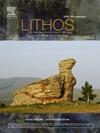青藏高原日喀则蛇绿岩中鲁曲超镁铁质岩石的构造-热演化:对慢-超低扩张脊洋岩石圈增生的启示
IF 2.5
2区 地球科学
Q2 GEOCHEMISTRY & GEOPHYSICS
引用次数: 0
摘要
藏南雅鲁藏布缝合带日喀则蛇绿岩中的鲁曲超镁质岩石被解释为形成于慢-超低扩张脊的新特提斯洋幔的残余物。因此,它们为该构造背景下的次脊地幔动力学和演化提供了有价值的见解。本文对具有代表性的哈尔茨布尔岩及其伴生辉石岩脉的主要和微量元素组成及变形显微结构进行了全面的研究。辉钼矿主的特征是不相容元素极度耗散,而相容元素富集,这与浅部(尖晶石相)次脊地幔高度(~ 13 - 18%)无水部分熔融相一致。辉石岩脉的矿物组成与宿主黑茨伯尔岩相似,可能是由源自软流圈的富硅熔体结晶而成,随后在洋中脊下方的岩石圈-软流圈边界(LAB)与宿主岩石相互作用并达到平衡。显微结构特征——包括斑岩碎屑织构、晶内塑性指标(例如,不溶性消光、亚晶界、扭结带和弯曲的脱溶片)、弯曲的橄榄石晶界和明确的晶体学——橄榄石(A/ d型)、正辉石(ac型)和斜辉石的优选取向——表明由位错蠕变主导的高温(~ 1000-1200℃)、低压(~ 3 kbar)变形。这种塑性变形推迟了熔融-岩石相互作用,并伴随着相对缓慢的冷却,从>;1200°C到~ 1000°C,估计速率为~ 8.5 × 10 - 4°C/年,这是由LAB的亚水平基底剪切和传导热传递驱动的。随后,较低温度(800℃)的脆性变形阶段由沿裂缝和晶界分布的含水矿物(如透闪石、花青石、绿泥石、滑石和蛇纹石)证明。这一阶段可能是由于海水沿海洋剥离断层渗透,促进水化反应,并以每年1.4 × 10−1°C的速度从~ 1000°C迅速冷却到<;700°C。在此基础上,提出了新特提斯慢-超低扩张脊环境下鲁曲超镁质岩演化的构造-热模式。本文章由计算机程序翻译,如有差异,请以英文原文为准。
Tectono-thermal evolution of Luqu ultramafic rocks in the Xigaze ophiolites, Tibetan Plateau: Implications for oceanic lithosphere accretion at slow-to-ultraslow spreading ridges
The Luqu ultramafic rocks from the Xigaze ophiolites in the Yarlung–Tsangbo Suture Zone, southern Tibet, are interpreted as remnants of the Neo-Tethyan oceanic mantle formed at slow-to-ultraslow spreading ridges. As such, they offer valuable insights into sub-ridge mantle dynamics and evolution in this tectonic setting. This study presents a comprehensive investigation of the major- and trace-element compositions of minerals, as well as deformation microstructures, in representative harzburgites and associated pyroxenite veins. The harzburgite hosts are characterized by extreme depletion in incompatible elements and enrichment in compatible ones, consistent with high degrees (∼13–18 %) of anhydrous partial melting in a shallow (spinel-facies) sub-ridge mantle. The pyroxenite veins, with mineral compositions similar to those of the host harzburgites, likely crystallized from silica-rich melts derived from the asthenosphere, which subsequently interacted and equilibrated with the host rocks at the lithosphere–asthenosphere boundary (LAB) beneath a mid-ocean ridge. Microstructural features—including porphyroclastic texture, intracrystalline plasticity indicators (e.g., undulose extinction, subgrain boundaries, kink bands, and bent exsolution lamellae), curved olivine grain boundaries, and well-defined crystallographic-preferred orientations in olivine (A/D-type), orthopyroxene (type-AC), and clinopyroxene—indicate high-temperature (∼1000–1200 °C), low-pressure (∼3 kbar) deformation dominated by dislocation creep. This plastic deformation postdated the melt–rock interaction and was accompanied by relatively slow cooling from >1200 °C to ∼1000 °C at an estimated rate of ∼8.5 × 10−4 °C/year, driven by sub-horizontal basal shearing and conductive heat transfer at the LAB. A later, lower-temperature (<800 °C) brittle deformation stage is evidenced by widespread hydrous minerals (e.g., tremolite, anthophyllite, chlorite, talc, and serpentine) occurring along fractures and grain boundaries. This stage likely resulted from seawater infiltration along oceanic detachment faults, promoting hydration reactions and triggering rapid cooling from ∼1000 °C to <700 °C at a rate of ∼1.4 × 10−1 °C/year. Based on these observations, we propose a tectono-thermal model for the evolution of the Luqu ultramafic rocks within a Neo-Tethyan slow-to-ultraslow spreading ridge environment.
求助全文
通过发布文献求助,成功后即可免费获取论文全文。
去求助
来源期刊

Lithos
地学-地球化学与地球物理
CiteScore
6.80
自引率
11.40%
发文量
286
审稿时长
3.5 months
期刊介绍:
Lithos publishes original research papers on the petrology, geochemistry and petrogenesis of igneous and metamorphic rocks. Papers on mineralogy/mineral physics related to petrology and petrogenetic problems are also welcomed.
 求助内容:
求助内容: 应助结果提醒方式:
应助结果提醒方式:


